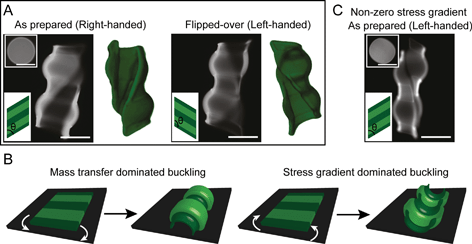Additions and corrections
Swelling-Driven Rolling and Anisotropic Expansion of Striped Gel Sheets
Myunghwan Byun, Christian D. Santangelo and Ryan C. Hayward
Soft Matter, 2013, 9, 8264–8273 (DOI: 10.1039/C3SM50627D).
Amendment published 28th October 2013.
Figure 7 and the associated discussion incorrectly describe the direction of preferred buckling of striped gel sheets. While the assignment of a left-handed helix in Fig. 7B-C is correct, these observations were mistakenly made on a sample that had been flipped over prior to swelling, yielding an effective angle of θ > π/2, not θ < π/2 as stated. Subsequent experiments (A-B in the Figure below) revealed that samples with θ < π/2 consistently formed right-handed helices when swelled in their as-prepared orientation, while they consistently formed left-handed helices when inverted before swelling. Thus, we conclude that there is little or no inherent preference for the sheet to buckle in either direction, consistent with the tendency of reference disks (lacking any in-plane pattern of swelling) to remain flat, as shown in the inset to A below. Instead, up/down symmetry is apparently broken by the presence of the underlying substrate, which impedes mass transport of water into the gel sheet. As illustrated in B below, the preferential flux of water into the top surface of the sample yields a gradient in stress through the film thickness that causes the sample to buckle “down”, i.e., with the central region of the sheet rising off of the substrate.
However, under certain conditions, a gradient of stress through the sample thickness can overwhelm the effects of mass transport. For samples where reference disks do show an appreciable degree of buckling (presumably due to residual stresses developed during solvent casting), as in the inset to C below, as prepared samples with θ < π/2 can indeed form left-handed helices upon swelling.

Figure 7
For samples where reference disks (inset in (A)) do not buckle, helical striped sheets can adopt either handedness depending on their initial orientation, suggesting that up/down symmetry is broken by more rapid adsorption of water through the top surface, rather than an inherent preference for a buckling direction, as shown schematically in (B). However, with appreciable stress gradients, reference disks (inset in (C)) show buckling, and this inherent preference for a buckling direction can overcome the effects of mass transport, leading to left-handed helices for as-prepared samples. All scale bars are 200 μm.
The Royal Society of Chemistry apologises for these errors and any consequent inconvenience to authors and readers.
Back to article
